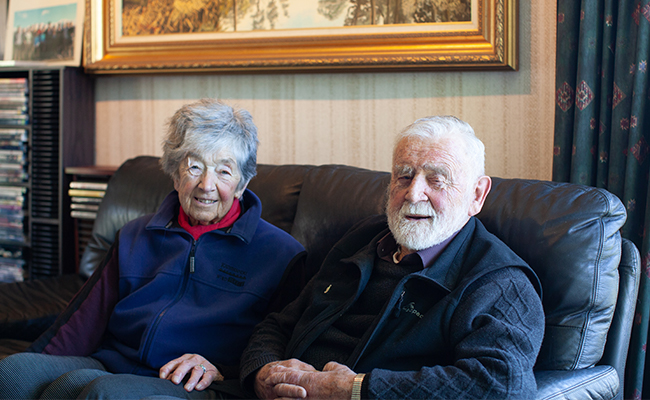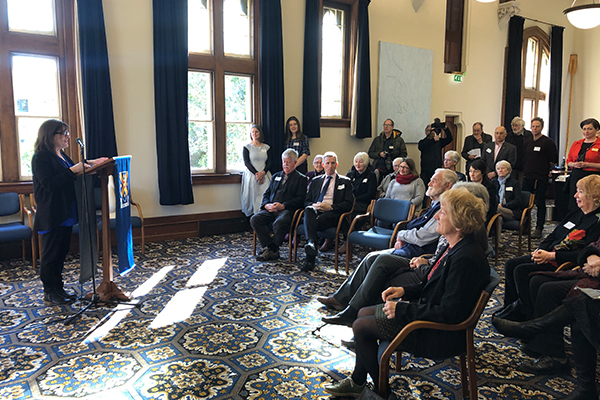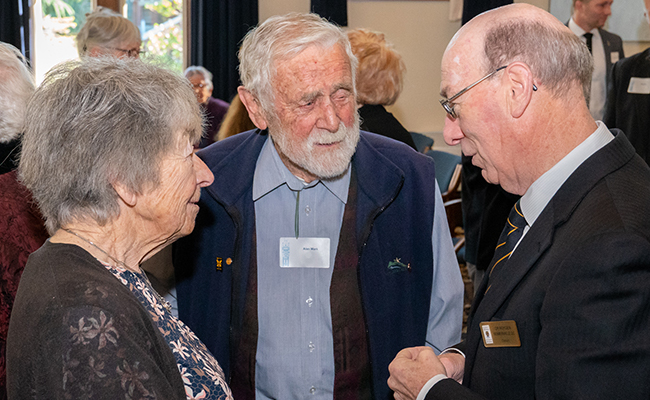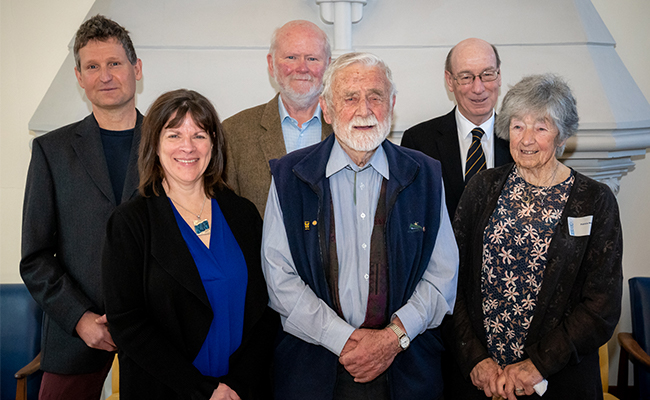Wednesday 30 September 2020 2:17pm

Lady Patricia and Sir Alan Mark have made a generous gift to the University's Ecology Fund.
When interviewing Emeritus Professor Sir Alan Mark and Patricia (Pat), Lady Mark QSO it feels very fitting to sit beneath a large painting of South Westland forest, facing a bookcase stuffed with natural history books – the signature green cover of JT Salmon’s Native Trees of New Zealand encroaching into the room.
If ever there was a couple immersed in the conservation, and appreciation, of New Zealand’s natural environment, it has to be the Marks. From the time they met at the University of Otago as Botany students in the early 1950s, through decades of advocacy for New Zealand’s natural habitat and wildlife, right up to the threats facing our new pandemic-stricken world, they have walked the talk when it comes to speaking up and taking action to protect our environment.
Their latest act to help further the aims of environmental conservation, and boost ecological education, comes in the form of two substantial gifts. It was announced today that the Marks have donated $150,000 to the University of Otago’s Ecology Fund and $100,000 to Orokonui Ecosanctuary.
Their lifelong contribution to the conservation and preservation of New Zealand’s natural habitats and wildlife was acknowledged and honoured at a function at the University this morning.
“Both of us came into university from working class families, interested in getting a good education which at that time was basically free to those who put the effort in – only those who had to repeat a subject paid course fees,” says Sir Alan. Both were the first in their families to attend university.
“The University, and wider New Zealand, has for a long time benefitted greatly from the contribution made to society by Sir Alan and Lady Patricia. This wonderful gift to Ecology at Otago will continue their legacy by supporting a field that is integral to the protection of our environment and the well-being of future generations. It will also help ensure students have the means to support their research in this vital area.”
“Today it’s a different story. The people who are disadvantaged or without substantial financial means I think have a much more difficult time getting to the University, so we have put some money into education for those of the disadvantaged group, which we ourselves were party to and got through at a time which was much easier than now.
“And I’ve got so much out of the University through ecology, and to me the field of ecology is absolutely fundamental to promote at this time, that I felt putting some funding into ecological projects and ecological activities was a worthwhile investment for the future.”
Vice-Chancellor Professor Harlene Hayne says the University is extremely grateful for the generous gift from the Marks.
“The University, and wider New Zealand, has for a long time benefitted greatly from the contribution made to society by Sir Alan and Lady Patricia. This wonderful gift to Ecology at Otago will continue their legacy by supporting a field that is integral to the protection of our environment and the well-being of future generations. It will also help ensure students have the means to support their research in this vital area.”
Sir Alan says Orokonui is an example of an organisation that is really making the effort to re-establish and maintain indigenous biodiversity and ecosystems.
“We felt it worthwhile to put some funding in to assist it with its very worthwhile efforts in conservation, ecosystem restoration and maintaining biodiversity with some of our endangered species,” he says.
Chair of the Otago Natural History Trust, the governing body of the Orokonui Ecosanctuary, and Otago Emeritus Professor, Colin Campbell-Hunt says the Orokonui Ecosanctuary will be eternally grateful for the generous support given by Lady Patricia and Sir Alan.
“We also want to say thank you on behalf of the precious biota of New Zealand’s flora and fauna. Sir Alan and Lady Patricia have devoted much of their lives to defending the country’s threatened ecology from the predations of introduced species, humans included. Their support for Orokonui is just one of so many ways that New Zealand’s ecology will be the better for their devotion,” says Professor Campbell-Hunt.
>
Vice-Chancellor Professor Harlene Hayne thanked the Marks for their generous gift.
From Roan Mountain to the high country, the lakes and Yellow-eyed Penguins
Sir Alan and Lady Patricia met as first-year Botany and Zoology students at Otago in 1950, both having grown up in Dunedin. Lady Patricia graduated with a BSc in Botany and Geography and Sir Alan with a BSc in Zoology and Botany and an MSc in Botany. He then headed overseas to gain his PhD at Duke University in North Carolina, and Lady Patricia joined him after working at the Botany division of the Department of Scientific and Industrial Research (DSIR) library in Christchurch – one of many “book-lined” positions she has held over the years.
They got married on Roan Mountain, North Carolina, at “the highest farmhouse east of the Rockies”. On their return to New Zealand, Sir Alan worked initially for the Otago Catchment Board and then the Hellaby Indigenous Grasslands Research Trust. At this time he also took up a lectureship at Otago, the beginning of a long working association with the University.
As Sir Alan runs through a pragmatic account of a life and career spent at the forefront of major conservation efforts in New Zealand, each chapter begins with the science. And it’s clearly his commitment to following the science through to protect the environment which has often landed him front and centre of campaigns to conserve natural habitat such as the South Island high country, or the lakeshore of Manapouri and Te Anau.
At times, this was undoubtedly to the chagrin of those who had contracted him to the do research in the first place, such as the request from the NZ Electricity Department via the DSIR in 1969 to do a lakeshore survey of Manapouri and later Te Anau, in preparation for raising their levels to generate more power for the Bluff aluminium smelter. One of his students, Peter Johnson, conducted the Manapouri study with Sir Alan as supervisor.
“It was a highly controversial issue. Our study was to describe the vegetation pursuant to losing it with lake raising. By that time the campaign [Save Manapouri] was starting to heat up, and our information was pretty relevant to the campaign in terms of what would be lost, what would be the price of lake raising. So I became involved in the campaign.”
Their research showed the lakeshores were both highly vulnerable and diverse ecologically.
“I put the degradation down to the method of farming that was being used; grazing right after burning and generally unsympathetic management. That was my finding, which didn’t endear me to some high country run holders who were very traditional. A couple of them wrote to the Vice-Chancellor (Sir Robin Irvine) and asked for me to be disestablished from the University for undermining their traditional way of farming, but the Vice-Chancellor was highly supportive of my position and told the run holders as much.”
“Our information indicated that the loss would be huge – Lake Monowai had been raised two metres in 1926 and was just a mess of dead standing trees and stumps.”
In 1972 it became a major election issue. Labour had a landslide victory and soon after they confirmed their pre-election policy that the lakes would not be raised.
“They also contacted six of us who had been campaigning pretty hard for the lakes to form a Guardians of the Lakes group to advise government on managing the lakes in terms of avoiding any damage to the lakeshores. It was a motley group of the ‘cream of the rebels’; the local doctor at Te Anau, the head of Fiordland Travel, a civil engineer from Invercargill, a farmer and a motelier from Te Anau.” Sir Alan was chairman for first 26 years and the group is still going.
The other big issue of his career began with his work for the Hellaby Indigenous Grasslands Research Trust in the early 1960s, identifying the basis for the degradation of the South Island high country, and how to manage it sustainably.
“I put the degradation down to the method of farming that was being used; grazing right after burning and generally unsympathetic management. That was my finding, which didn’t endear me to some high country run holders who were very traditional. A couple of them wrote to the Vice-Chancellor (Sir Robin Irvine) and asked for me to be disestablished from the University for undermining their traditional way of farming, but the Vice-Chancellor was highly supportive of my position and told the run holders as much.”
He says the high-country issue has now been more or less settled. “I think we have won the day there, the management of the high country is much more enlightened now than it was. Although the recovery is very slow, it will take a century or more to recover, if it ever does.”
Sir Alan has also held influential positions in a number of other environmental campaigns and organisations. As National President of the Forest and Bird Protection Society from 1986-1990, he played a major role in securing the 2.6 million hectare South West New Zealand World Heritage Area: Te Wāhipounamu. As a National Parks and Reserves Authority member, and also with a comprehensive field study which he organised, he helped prevent the logging of the 45,000ha Waitutu Forest in western Southland, which has since been added to Fiordland National Park and South West New Zealand World Heritage Area: Te Wāhipounamu.

Lady Patricia and Sir Alan Mark speak with University Chancellor Dr Royden Somerville QC.
Sir Alan was elected a Fellow of the Royal Society of New Zealand in 1978. He was knighted in 2009 for his achievements in science-based conservation and received an honorary doctorate from Otago in 2014.
In terms of progress since the early days of his advocacy in conservation, he says “the most satisfying thing is the greater concern of the public with matters related to New Zealand’s unique biodiversity and ecosystems, and the importance of conserving them”.
Lady Patricia has also committed a huge amount of her time to several conservation organisations, including The Yellow-eyed Penguin Trust, the Otago Natural History Trust and the Mt Aspiring National Park Board.
“We had a lot of fun doing the Yellow-eyed Penguin work, working with people like David Bellamy who came to teach the unwashed colonials how to do things,” she says.
Professor Campbell-Hunt says “the Orokonui Ecosanctuary is primarily a community conservation project. Lady Patricia is one of a wonderful group of volunteers whose efforts make the sanctuary possible. Without the contributions of Lady Patricia (and scores more), the sanctuary simply could not have achieved what it has over the past decade.”
Lady Patricia is a JP, and as well as putting her energies into their family of four children, her love of books saw her working at different times over the years at the University library. She was awarded a QSO for services to the community in 2000.
“I liked the active side of things, I always enjoyed the field trips for Botany,” says Lady Patricia, who joined the Otago Tramping Club while still at high school. She and Sir Alan took an active part in the Science Students’ Association field trips, which ran for about 20 years until around 2000. They usually took place in the May holidays, and involved several University departments.
When Sir Alan went on sabbatical, the family always went too. “Which was unusual in those days,” she says. “There was no way I thought we should have children and not take them with us on these trips.”
With their children Jenifer, Stephen, Alastair and Bridget, their travels took them to many exciting places, including the Southern Appalachians, Edmonton, Chicago, Scotland’s Cairngorms, Wales’ Mt Snowdon, Innsbruck, Salzburg, Alaska, and other field sites.
“We were so privileged and lucky to be able to travel to places like the Galapagos, Cusco, Machu Picchu and Tierra del Fuego,” says Lady Patricia, who feels the increasing number of people visiting such places is changing the experience, and that it was a privilege to be able to appreciate the “loneliness and ability to get away from people”.
Of all the places they have been however, Fiordland remains their favourite. “Fiordland is amazing country. Norway is similar, but it doesn’t compare; Fiordland is unique,” says Sir Alan. The family has a cottage at Manapouri and together has tramped most of the tracks in the area.

Sir Alan and Lady Patricia Mark were both the first in their families to attend University.
Standing his ground
Sir Alan’s memoirs are entitled Standing My Ground, and he says being an advocate for the environment in the face of local and political opposition can be a lonely and uncomfortable place to be at times.
He is grateful to have always had the backing of the University, especially at those times when he was challenged by sectors of the community for his stand on environmental issues.
“It’s not easy in that role. The amount of abuse you get can be quite considerable…the criticism from the powers that be, political lobbyists. From my point of view several high country run holders were onto me in a major way and to have the University stand up and defend you is so important and so reassuring, because you are vulnerable and to have that sort of support when it’s needed is so important to be able to maintain the role.”
He thinks it is wonderful there is now an award publicly recognising the role of Critic and Conscience of Society, which is specified in the Education Act as a responsibility of academics.
When he was awarded his honorary doctorate, Professor Hayne described Sir Alan as “an inspirational figure, not only at Otago but much further afield. He is an excellent example of an academic who is an effective critic and conscience of society - one whose standing is grounded in leading research and is expressed through service to the community."
Getting the public behind a cause can also be a challenge. “Educating the public over issues of environmental and ecological importance is no mean feat. You’ve got to be at it continuously and simplify the situation; often you’re accused of fudging the information or misrepresenting it because you’re trying to simplify it so the public can better appreciate it, it adds to the difficulty really.”
He says if the National Party had won the 1972 election he would have “gone down the gurgler. Whereas with Labour winning I was flavour of the month; that’s the risk you take really.”
Where to from here
Most recently, Sir Alan has chaired the Wise Response Society which lobbies for a sustainable future for the country, on the five platforms of global warming and climate disruption; ecological and environmental security; human well-being; economic security; and business continuity.
“I fear for my grandchildren, what sort of an environment we will leave them…I think my generation has had the best of the environment and what the future holds is to me not very enlightening, not very encouraging. I’m certainly doing my best, along with many others, to make the point that we must mend our ways to have a sustainable future.
“The group is concerned with the importance of sustaining the environment and not over-capitalising and over-exploiting it to the detriment of the sustainable aspects of the system,” says Sir Alan.
“What COVID-19 has shown is that given a very serious situation the country can adapt and we’re trying to ensure that in the recovery from COVID-19 an opportunity is taken to recognise that pre-COVID we were operating in a non-sustainable growth system and hopefully we can mend our ways to reduce growth to the point where the systems that we depend on can be sustained in perpetuity.”
As for any advice he would give to younger generations on how to approach the environmental challenges facing them, his answer is clear: “civil unrest”.
“I fear for my grandchildren, what sort of an environment we will leave them…I think my generation has had the best of the environment and what the future holds is to me not very enlightening, not very encouraging. I’m certainly doing my best, along with many others, to make the point that we must mend our ways to have a sustainable future.
“Extinction Rebellion is an organisation that was established in Britain which is now worldwide and their voices are being heard, and the school children’s march for climate action has got to be one of the important methods of demonstrating concern. I’ve certainly supported all of their causes. That sort of civil unrest, civil disobedience is I think perhaps the best way. Trying to persuade the political process that they need to mend their ways has not really worked to date.”
Sir Alan and Lady Pat say they decided to gift the money to the University and Orokonui now rather than leave it as part of an estate in the hope that “the attitude” of the gift will encourage others to do the same, and “hopefully we will see something of the benefits from it”.
Story by Margie Clark, Communications Adviser (Development and Alumni Relations Office)
